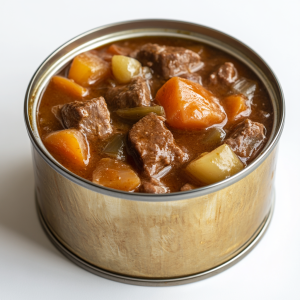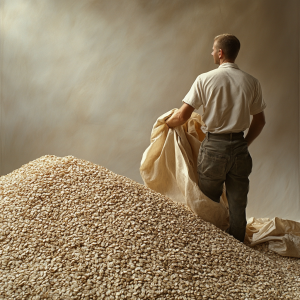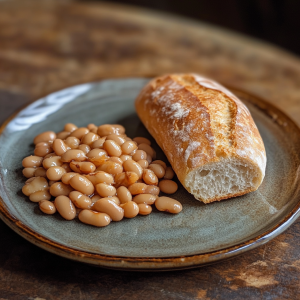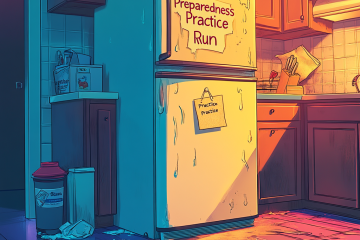
Can you live off of a 4 inch loaf of bread and 1/3 cup of beans once a day?
“How much food storage do I need?”
A common question I get asked.
For the record, I absolutely loathe the term “food storage.” It’s no longer used in my vocabulary because I’m not a squirrel. I wrote a whole 500 page book on kitchen preparedness without using the term once except in quotation marks. I don’t purchase items that serve no other purpose than to be stuffed away into a corner, only to promise unpleasant eating later. If I don’t eat it or know how to use it, it doesn’t come into my home. And if it comes into my home, I use it and am very familiar with it.
Now, having said that, the question posed above is a common question in my line of work because others don’t necessarily share my point of view. That’s okey dokey. Regarding having “enough” there are certainly plenty of numbers thrown out there. I do have an opinion to add to that list of suggested amounts, of course, though I confess that my answers aren’t always well received—I have this nasty habit of sharing facts that may contradict what a person has relied upon for a long time. *wink* So, how much food do you really need in order to have a year’s supply for your family at any given time?
Do you have the right kind of food storage?
In my book, there’s nothing worse in my book than having a false sense of security. I will never forget the time that I was invited to “take a peek” at the newly acquired “year’s supply of food storage” that a friend of ours had purchased. This friend was just so tickled and so proud of himself for finally getting out there and doing something about providing better for his family in the future. Frankly, I always join in someone’s peace of mind when they are moving towards a more self-sufficient life. But on this occasion, my joy for this friend was short-lived. This friend has a wife and 5 children, so imagine my husband’s surprise when our friend showed him 365 regular sized soup cans of a hearty stew. Yes, you read that right, folks. In this man’s mind, 365 cans of soup for a family of 7 is enough food for a year. Ooops! Now mind you, I’m a believer in miracles yesterday and today, but as I understand things, I don’t think that we’re supposed to put ourselves in a position in which we require a miracle to survive, as long as we can help it. There are SO many things wrong with this scenario I’ve just shared with you, but let’s just focus on the obvious here(Appetite fatigue? Lack of comfort food? Stress?)—he doesn’t have anywhere NEAR enough food for his family to last him a year.

One can of beef stew to feed 7 people?
In the world of “emergency preparedness” there are many resources which will help you calculate exactly how much food storage should you stock up on for your targeted time frame. An internet search for a “food storage calculator” will bring up lots of nifty little sources. Since the Church of Jesus Christ of Latter-Day Saints (commonly referred to as “Mormons”) has been urging it’s members consistently since the 1800’s to have “food storage” I’m comfortable sharing with you there suggested guidelines to help you get an idea of “how much food storage do I need.” See the calculator here:
The first thing you will see on the usual food storage lists that are out there is the category of “grains”. The standard rule of thumb you’ll hear most often is 300 pounds of grains per person, regardless of what their age is, for a year. I always plead that people NOT quibble about the ages of the persons in their family because it’s obviously likely to change… after all, kids get bigger with time, not smaller. So since one doesn’t know when they will have to rely strictly on their year’s supply, it’s a good idea to prepare with the “worst case scenario” of needs of older kids in mind.
Now grains constitutes all kinds of grains items such as flour, pasta, rice, muffin mixes, popcorn, spelt, quinoa, wheat, cereals, etc. (Notice we’re talking about WEIGHT here, so keep that in mind when you’re looking at that very big, but oh, so light box of Cheerios.) Again, the most common rule of thumb amount for grains is 300 pounds. I’ve actually never said anything less than 350 pounds, but regardless, nearly all of you who are reading this will have that momentary shock to the system as you contemplate just how much grain that would mean for a family of 4, let alone 7. Imagine how much that family on cable TV with 19 kids would need! Whoo-ee!
Inevitably when I share the magic number of 350 pounds I will always hear someone declare “Oh, there’s no way that I consume that much grain in a year.” Well, either you live off of Hershey’s candy bars and plan on just leaving this life in a chocolate coma–perhaps not the worst that could happen *grin*—or you really don’t have a grasp on just how much a person actually consumes in a year. So think about this for a moment. Does your money ever last as long as you think it will? Surely you’ve experienced that “holy cow” moment in your life when you realized how fast that “extra $100” in your wallet disappeared. And surely you’ve at least seen plenty of folks who thought they had enough gas in their car to get them to their destination even though the needle was sitting on “empty.” And of course you’ve all experienced one of those days where you have no idea where all the time went, right? Well then, isn’t it fair to say that when it comes to the topic of long-term food consumption there just might be a bit of perception error? And I’m about to show you just how far off that perception is in most homes–and I”m talking about homes in which people actually consider themselves to be mindful of these kinds of things. Wait until I show you just how LITTLE that 300-350 pounds of grain in your food storage will provide you in the form of daily meals. (You actually consume 152 pounds of grains on average now per year, but that’s WITH the 185 pounds of meat and poultry, 273 pounds of fruits and 415 pounds of vegetables each year. So unless you’re going to stock up on those too, your grain will be your primary resource.)
The absolute minimum amounts of recommend food supplies for a year which provides you with “about a half of a small loaf of bread daily along with 3 small servings of beans” (notice the quotation marks) are as follows:

You actually consume an average of 152 pounds of grain per year now, but that’s with all your other foods available to you.
300 pounds of grains per person (FYI, a pound of grain–depending on type–is between 2 1/4 – 2 1/2 cups)
75 pounds of legumes (pinto, black, red, lima, kidney, turtle, garbanzo, etc.)
75 pounds of milk (powdered, evaporated, etc.)
65 pounds of sweeteners (sugar, molasses, honey, etc.)
4 pounds of shortening*
2 gallons of oil *
2.5 pounds of leaving agents (yeast, baking soda, baking powder, etc.)
5 pounds of salt
45 gallons of water **
*This does NOT include other fats which are absolutely necessary for proper organ function such as butter, coconut oil, peanut butter, nuts, etc.
 **this is ONLY enough for an average of 3 daily consumable ration examples as noted below and does NOT include the minimum of 2 quarts of water each person should drink daily—minimum for proper body function, nor does it take into account any additional water needs such as laundry, bathing, sanitation, or any additional cooking.
**this is ONLY enough for an average of 3 daily consumable ration examples as noted below and does NOT include the minimum of 2 quarts of water each person should drink daily—minimum for proper body function, nor does it take into account any additional water needs such as laundry, bathing, sanitation, or any additional cooking.
That’s a LOT of Food Storage, RIGHT?!!!
So, you see these massive amounts of food storage and think “Holy cow, that’s a LOT!” but I’m going to show you what JUST THESE items translate into a 3 times (corrected)DAILY RATION basis. Ready? Brace yourself…

THIS is all that the recommended amount of food storage would provide come mealtime
Copyright 2012 Preparedness Pro All Rights Reserved
You see this pittance of an amount of beans and this tiny, UNdelectable 4-inch “ loaf” of bread? That’s what this “massive” amount of food translates into what you get to look forward to three times a day for one person. Mmmmm…you’re just salivating like crazy right now aren’t you? Wow! That’s quite the feast there… Bet you can’t wait to dig into that, eh? Every meal…every day… 365 days… That’s basically a biscuit and a few bites of beans, folks.
Here’s what was used to make this bountiful feast you see in the picture:
¾ cup of grain (equals about 1 to 1 ¼ cup of flour IF and only IF you’re able to mill grind it)
1/3 cup of beans
2 Tablespoons of powdered milk
2 Tablespoons of oil (fat, lard, butter, etc.)
1 Tablespoon of sugar (in order to best activate the yeast)
2 ½ teaspoons of yeast
2 ½ teaspoons of salt
And approximately 24 ounces of water to cook the beans, make the bread, and for SOME drinking water in order to ward off digestive ailments.
What do YOU want your food storage to look like?

Where’s the meat?!
Copyright 2012 Preparedness Pro All Rights Reserved
Now, is there anything else missing…you know like fruits, vegetables, flavorings and spice, comfort foods, etc? How about some MEAT like chicken, ham, or beef? And where in the heck is the chocolate—medication of the sane?! And this isn’t exactly going to make my Blue Ribbon Kick Butt 100% Whole Wheat Bread either. Even if it did, I can tell you that most people can happily polish off a whole loaf of a REAL sized loaf of bread in the first 24 hours after I’ve baked it, and I assure you, that’s not all that they eat when I make bread…the irresistible, moist, light bread is consumed in addition to his regular meals. Seriously, can you even fathom serving your children or your elderly parents and grandparents nothing but this speck of food every day? This puts things in a little different perspective, I hope.
Perhaps now you understand why I cringe when people focus so much on traditional “food storage”? It’s simply NOT as abundant as people think it is, nor does it provide anywhere near enough calories to THRIVE. Let alone the mental food necessities to thrive. This kind of a minimalistic “preparedness” will not serve much more than to buy you a little bit more time before your most certain death—especially if you haven’t taken thought for the tools and skills needed to GROW and produce additional foods so that you’re not doomed for death by starvation on Day #375.
Consider this also…what about your INCREASED physical demands for nutrients because you’re having to do more  physical labor that a true crisis scenario would demand? How about just lugging your bug-out bag for 5 miles every day? You think that this paltry amount of food will be enough to fuel your body and your spirit so that you can do that? How about the energy you’ll need to shovel a latrine, be alert and on guard, or washing laundry by hand? Can you also imagine just how grumpy people would be in an already stressful situation because this is all they have to eat?
physical labor that a true crisis scenario would demand? How about just lugging your bug-out bag for 5 miles every day? You think that this paltry amount of food will be enough to fuel your body and your spirit so that you can do that? How about the energy you’ll need to shovel a latrine, be alert and on guard, or washing laundry by hand? Can you also imagine just how grumpy people would be in an already stressful situation because this is all they have to eat?
So, do you have enough food storage? Um…I’m thinking that at least double these minimal amounts of food is much more in line with the reality you’ll want to deal with in the event that life drastically changes for us.
Join our Facebook Group!




108 Comments
rebelchicken · May 4, 2012 at 11:15 am
The visual here says it all! Great post!
Phil · May 7, 2012 at 1:15 pm
When I looked at the picture, all I thought was, “holy cr*p! I am soooo not ready!” What I find really hard is getting the volume of grain shipped in to me. I have to order from across the country and though the grain in the 6 gallon containers is relatively cheap, the shipping is not. I’ve got maybe 5-600lb of grains in total stored, in addition to a very wide variety of tinned,bottled fruits,veggies, spices and #10 cans of freeze-dried foods, about 140 tins. I suppose I have enough to last the 5 of us about six months at best. Gotta get crackin’ on filling up the shortfall!
Kellene Bishop · May 7, 2012 at 4:01 pm
Phil, one of the things our family did when we didn’t have the luxury of access to all of the grain we wanted was to get a bunch of neighbors/friends to go in together on a purchase and use freight instead of standard shipping. When you’re talking about that kind of weight it’s SO much easier. Also, believe it or not, grocery stores WILL special order for you and doing so you won’t pay nearly the freight that you might otherwise.
Kellene Bishop · May 10, 2012 at 2:56 am
Phil, Five Star Preparedness has a KICKIN’ special going on this month for the essentials. Even with the shipping you’ll fare better than if you were to purchase from the stand-bys such as Honeyville, Wal-Mart, Emergency Essentials (ugh), etc. and better yet, I KNOW that what they are carrying is GMO free and has not been irradiated too. just go to their site http://www.FiveStarPreparedness.com
Vi with Survival Skills · May 8, 2012 at 1:05 pm
Bear in mind tho, that learning the SKILLS is just as important as having all the ‘stuff’ – someone can steal you blind in one night, and then you totally have to rely on your survival skills.
On another note, I LOVE the shelving in the picture. Cinder blocks and planks makes for the best kind of shelves, plus you have extra building items which might come in handy as well.
Sueann · May 4, 2012 at 12:34 pm
Wow, what an eye opener. Have a question…how do you politely instruct the ignorant friend that what he has isn’t enough without seriously offending them?
Kellene Bishop · May 4, 2012 at 4:05 pm
well, I’d share the article with “him”–and besides, I”d much rather offend him than have to bury him. 🙂
lilly · May 4, 2012 at 12:57 pm
Thank you, very scary but an eyeopener..
Robin · May 4, 2012 at 1:15 pm
Fantastic presentation. This really puts it in perspective.
Erica · May 4, 2012 at 1:21 pm
Exactly. People make fun of me all the time because when I get groceries I will buy a big bag of rice or beans and add a few cases of food into my food storage. I just don’t tell anyone about my monthly orders for freeze-dried food and grains. I have a family of five and I don’t have any illusions about having enough food. I will never have enough food, but I will do my best to see that there is. Thank you for this post! Keeps me motivated to do more!
Melissa · May 4, 2012 at 1:42 pm
Can you share your wonderful sounding bread recipe?
Kellene Bishop · May 4, 2012 at 4:03 pm
Already done…just search for “kick butt” and the article with the recipe will come up. 🙂
AL · May 4, 2012 at 1:44 pm
Like so many preparedness people, I think it is best to with the basics, and then as one is able to add the things that will not only sustain life, but will make it bearable and dare I say even enjoyable, such as freeze-dried fruits and veggies, meats, treats (I am so with you on the chocolate-as long as I have nuts of some kind to go with it 🙂 ). The freeze dried meals in a #10 can are expensive, but on some days, wouldn’t it be nice to come in to a hot, easy can of stew along with a LARGE loaf of bread?
Kellene Bishop · May 4, 2012 at 3:56 pm
that’s why I can my meats—cheap and oh so delicious. 🙂
Benita Hyde · May 5, 2012 at 8:09 pm
I am just getting ready to start canning my own meats, do you know about how long they last? just curious. And do you have articles on how you can your meat? Thank you Kellene.
Benita Hyde 🙂
Kellene Bishop · May 5, 2012 at 9:39 pm
As per the two articles I’ve published on this site regarding the canning of meats, you should easily have 8 years of shelf life.
Joanne Rigutto · May 7, 2012 at 1:56 pm
Canning is an excellent way to preserve meats in a ready to eat form. I recently was without much in the way of income and what I did have had to pay for utilities, so I lived off the larder for the most part for about 3 months. Ate several cases of canned emu, elk, venison and buffalo, some of which was 5 or 6 years old.
I’m having a beef slaughtered this summer and maybe half of her is going into cans, the rest to the freezer, although I may dry or smoke some.
I’m currently 6 months into a project where I’m keeping track of the foods I use and quantities for a year. I decided to do this specifically to see how much I use (I’m only counting what I use to make calculations easy to extrapolate to a family) in order to put up a one year larder. I also have a small farm and produce and process a lot of my own food. I raise my own meat animals and do my own slaughter on the smaller ones like poultry, fowl, rabbit and goat.
This is a good article and spot on as far as the quantities go.
Yolanda Breidenbaugh · February 14, 2014 at 3:23 pm
Joanne, please tell me more
Joanne, please tell me more about your meat canning plans. I have canned some meat in the past – bacon ends and pieces that I use when I make soup, chicken breast that I’ve used in various ways and bulk sausage and sausage patties. I love having the canned meat on the shelf. But I do have an opportunity to buy a whole, half or quarter beef, and if I could do that… I am just not sure how to proceed. What “cuts” do you can, or do you just cut it all off the bone and can it? I hope you can give me some ideas.
Preparedness Pro · February 14, 2014 at 7:49 pm
Yolanda, you’re actually
Yolanda, you’re actually already on a site that has excellent information on how to can meats–including detailed instructions and pictures. (chicken, bacon, bacon pieces, sausage, etc.) We even have a detailed how-to video on canning hamburger. Just put “Canning Meats” in the search bar.
Ammie · May 4, 2012 at 1:47 pm
This post is exactally why I put so much variety in my stockpile. Can you imagine eating only this day after day! Thanks Kellene, you have just solidified my attempts and my goals for a varied diet. I was once asked why are you stocking “that”. My response to these kind of questions is always:
why not! Yes I could stock just the basics, but if I can store things that would make life more comfortable now why shouldn’t I. Why store just rice and beans when I love tuna casserole. It tasts better and would be a welcome change from what you are eating!
As far as how much I am prepping, I have been using this method. I have made meal plans based upon what I eat in a month (this can varry each month). Example: Tuna casserole 2xs per month. Two cans of tuna, two cans mushroom soup, egg noodles, 2c. milk, 2c mashed up potato chips. So, 2 cans of tuna 2x’s per month for 1 year would be 48 cans of tuna, and thats just to make tuna casserole. Anyway, this is how I do it and maybe will help someone out!
Thanks for all that you do! Ordered my diatomaceous earth! Hope that it comes this week. Cant wait.
Holly Adams · May 4, 2012 at 1:49 pm
Wonderful article. Gives me renewed vigor in the quest to continue storing and encouraging others. Self sufficientcy is a full time job and I feel sorry for all the people who scoff at preparedness and mistake us as “crazy”. We are a family of 5 and teach our children self suffcientcy on a daily basis. Wake up from your government dependant livelihoods and take responsibility for yourself and your family!!!!
Connie · May 4, 2012 at 2:26 pm
Is there risk of meal worms getting in the flours, pastas, etc? What about the shelf life of the levening agents? Can the shortening go rancid?
Kellene Bishop · May 4, 2012 at 3:54 pm
Absolutely you can have critters in your food that’s why you 1) store them appropriately until ready to use (see diatomaceous earth on this site) and 2) don’t just put them away in a corner…store what you eat and eat what you store”. The same goes for the oils/shortenings.
Cindi · April 6, 2013 at 7:50 pm
If you put your grains in the freezer for a couple days after they are vac sealed that will keep the bugs out of them! NOT the mice though unfortunately!
Becky · May 4, 2012 at 5:55 pm
Your information on the extra storage is why I am cleaning out the items we have inherited over the years. No use to us, but taking up my space for my basic items, including food. I have shared your information with a friend and I will ship this article over to her, if her husband will get off the computer long enough for her to read it.
Bexter · May 4, 2012 at 6:10 pm
We slowly rotated the super old grains inherited from Grandma by feeding it to our chickens. They are free range, so a little grain along with the other stuff kept them happy for a long time.
Kellene Bishop · May 4, 2012 at 6:20 pm
I’m not 100% sure why, but this comment made me crack up. 🙂
Donna C. · May 5, 2012 at 1:53 pm
Oh, Kellene, maybe the “Your loss is my grain” comment from Facebook? lol
Patricia nerren · May 4, 2012 at 8:45 pm
My hubby told me this week I had plenty of food I don’t need any more..I just looked at him. Thinking to myself SERIOUSLY. so when I shop I will still buy. Just have to hide my buckets lol
Claire · April 28, 2014 at 11:35 pm
I’m right there with you,
I’m right there with you, Patricia. Yay for us “sneaky” preppers!
Glenda · May 5, 2012 at 12:58 am
I grow a raised-bed garden every year and last year had some “extra” spinach which I opted to dehydrate, package and store. (I don’t throw anything away or feel the quantity isn’t “worth” bothering with.)This will be added to omelets, soups, whatever. I mentioned that I had done this and one woman (mother of 5 and definitely food storage poor) looked at me like I was from Mars and said, “WHY?”
I saw a T-shirt this morning on a gentleman at the store which read: “Help the helpless and ignore the clueless”.
“Nuff said.
Katherin Keegan · May 5, 2012 at 4:29 am
I have recently started prepping for earthquakes here in Ca. My husband wasn’t on board to start with but we had a heart to heart and he agrees that something will give soon either from people or nature – it doesn’t matter. The last time he went to Costco he agreed to get the 25lb of rice & pinto beans. We won’t have enough of everything for 6 months for the four of us for awhile, but better late than never. This article showed me how much we don’t have yet. I hope to have a lot more stored before it’s needed.
John · May 5, 2012 at 4:37 am
What about storing vitamins?? If we are only getting just the bare minimum to eat every day, taking some vitamins could help to fill in the missing nutrients.
Kellene Bishop · May 5, 2012 at 9:48 pm
Sprouting gives you the vitamins you need with a significantly longer shelf-life AND with nutrients that are actually absorbable in the body. Pills typically do not and they have a woefully inadequate shelf-life.
Melody · May 5, 2012 at 10:31 pm
I suppose that all depends on what source you choose to believe. This from PubMed says that studies do not show that sprouting markedly increases the nutrient content of grains. Might not hurt to have some vitamins on hand.
http://www.ncbi.nlm.nih.gov/pubmed/7002472
Cereal sprouts: composition, nutritive value, food applications.
Lorenz K.
Abstract
The practice of sprouting of cereal grains has become popular in the western world. Sprouted grains are thought of as having exceptional nutritive value. Sprouting is easy and can be done without sophisticated equipment. Untreated seeds of good quality and high germination percentage are placed in an environment of adequate water, a desirable temperature, and a certain composition of gases in the atmosphere for several days for sprouting. The sprouts can be kept for a few days to over a week under refrigeration. They can be used in many different foods including breakfast items, salads, soups, casseroles, pasta, and baked products. Sprouting of grains causes increased enzyme activity, a loss of total dry matter, an increase in total protein, a change in amino acid composition, a decrease in starch, increases in sugars, a slight increase in crude fat and crude fiber, and slightly higher amounts of certain vitamins and minerals. Most of the increases in nutrients are not true increases, however. They simply reflect the loss of dry matter, mainly in the form of carbohydrates, due to respiration during sprouting. As total carbohydrates decreases, the percentage of other nutrients increases. There are no nutritional evaluations of cereal sprouts in humans. Animal studies with cattle, pigs, chickens, and rats have failed to show a superior nutritive value of sprouted grains over ungerminated grains. Studies with humans are not likely to produce more encouraging results.
Kellene Bishop · May 6, 2012 at 12:33 am
Seriously, I have no idea how some so-called experts get away with writing such dribble without being sued. But then again, we have the AMA, FDA, NIH, USDA, and the Federal Reserve…how silly of me. Perhaps these are just the same experts who came up with the brainiac of an idea that smoking was good for you, that The Federal Reserve was a good thing, and the putting fluoride in our water was in the best interest of mankind. Do these guys all hang out at a club on Friday nights and write this stuff up?
Your link deals primarily with cereal grains. You’re aware that you can also sprout vegetable seeds and nuts too, right? Again, sprouts have a significantly longer shelf-life than do chemicals mixed with gelatins, petroleum products, or fillers. Additionally, you can sprout just about any whole seed, grain, or nut, so a lot of vegetables such as broccoli and radish seeds can provide us with some fantastic nutrients via sprouting. Sprouts are simply the better choice. plain and simple.
You don’t have to be a botanist to understand the most basic fundamentals to the principles of sprouting. Sprouting wheat for about 3 days provides 500-600% nutrition than the wheat kernel provides in it’s traditional use, even if it was just about SIZE as opposed to the enzymatic change that goes on. Saying that sprouting does nothing is literally like saying that a baby is no differently developed than an embryo.
Tell me which science study has EVER determined that our body absorbed the chemical nutrients put into vitamin pills? Or show me a consistent flow of food that actually HAS even the most basic of assumed nutrients in it anymore. The San Juaquin Valley that was used back in the 1980’s contained only a small fraction of a percent of nutrients in the soil–this is the farmland that was and is still owned and used by Green Giant to grow our vegetables–of which people eat so few now.
So even if this study were accurate, it doesn’t take into account what nutrients we clearly no longer have in our food nor our body’s inability to absorb and properly use chemicals poorly disguised as nutrients. Ask any guy who’s worked the sewage systems and he’ll tell you what he sees the most…vitamin pills.
By the way, relative to sprouting and the art of zymurgy, you may want to check out Dr. Weston Price’s work–he actually spent over 20 years studying the results of sprouted or fermented nutrition in the lives of many people–I think it’s a far cry from someone who’s published something on PubMed.
Please use some common sense. folks.
Joanne Rigutto · May 7, 2012 at 2:15 pm
Sprouts can be a good source of many nutrients, but if you’re going to be sprouting a lot you’ll need lots of seed to store. I grew micro greens for restaurants last year and may again this year, depending on my work load and the demand for them.
What I found out was that you use a LOT of seed. I went to buying seed by the pound or part pound for a lot of different leafy greens and vegetables. For the home gardener, sourcing seed in those quantities can be problematic, Fortunately, most large seed suppliers are online and a person can get just about any kind of seed they’d like as long as they have the money for it.
One thing that is handy in this type of disaster preparedness scenario would be the skill set necessary to grow and save seed in quantity. When you think about it, you can have a substantial larder, but if you’re growing your own, if you don’t have the ability to save seed, you’ll still run out. Harvesting and cleaning seed are relatively simple processes, but you do have to know how to do them, and you need to know what will cross and what crosses are palatable and what aren’t. I’ve had squash plants cross and the offspring were wonderful. I’ve had other crosses that were only good for animal fodder.
A couple other things a person can do is to plant seeds from their legume store. All of the pulses (dried beans and peas), unless they’ve been irradiated, will sprout and grow. Same for whole grains with the exception of white rice.
And, you can multi task some things. For instance, if you like beer, you can buy whole barley and wheat, do your own malting, which is a simple process. Once they’ve been ground and mashed, those spent grains can either be fed fresh to livestock and poultry, or they can be dried for storage and fed as a portion of the animals’ ration.
Mark · November 23, 2013 at 8:10 pm
She is just another victim of
She is just another victim of falsified studies and statistical lying. I wonder if Melody even looked at the z-scores of this so called “study”.
bob smith · October 7, 2012 at 4:24 pm
Plenty of books on living off the land, gathering wildfoods, wilderness survial, etc. Great resources to have on hand. for example, to ward of scurvy from vitamin C deficiency, you can make a tea from spruce needles. So, even if your stock of vitamins runs out, there are natural alternatives.
toby · May 5, 2012 at 5:03 am
When you think you have enough, you need three times more. I will never have enough food, water or ammo. If anyone out there has enough……. please tell me how much that is. Thanks
Fran · April 2, 2015 at 11:00 pm
Those are great things to
Those are great things to store and I recommend you get a great supply of them. When you feel you have sufficient food, water and ammo, think about clothes, TP, shoes, socks, boots, towels, shelter, and anything else you may need. We are never “done”.
Preparedness Pro · April 3, 2015 at 3:36 am
Fran, you should check out
Fran, you should check out our 10 Principles of Preparedness. Food is FAR DOWN the totem pole when it comes to what one should stock up on.
countrygirl · May 5, 2012 at 6:33 am
Great article and it adds a little pep to my storage food lethargy. I’ve been stocking away for a couple of years and just added a large box of canned spices to the “shelf”. I did the 300 lbs of wheat from the LDS cannery, plus buckets from here and there and I belive I have a year of goods, if you include the three freezers, shelves of canned goods and cases of freeze dried and dehydrated foods.
I know that in an emergency there will be a lot of soup and bread at my house. With some variety thrown in here and there.
countrygirl · May 5, 2012 at 6:34 am
It would be great if you did a follow up article on the commercial “year supply” food storage units. I feel sad that some people think these will sustain them.
Kellene Bishop · May 5, 2012 at 9:47 pm
you may want to look that up. I’ve written a “no holds barred” article specifically taking on companies like Daily Bread who bold face LIE to the customers about how many people their packages will feed.
Brescon · May 5, 2012 at 11:40 am
I’ve had this “discussion” on the APN just a few months ago. my concern is space. I’m trying to prep for 5 to 7 people for 1 yr. I just don’t have that kind of space so I’ve opted for the “servings” method. I calculate how many servings each item has & reduce it by 1 or 2 (so if the item has 5 servs, I reduce it to 3).
A lb of spag has 7/1/2 6 oz servs. I reduce that to 6 to do my calcs. I believe that when TSHTF we will be in an emergency situation, therefore a rationing situation. So we will ration until we get things under control and continually re-adjust our storage. another concern for me is water. I’ve stopped buying freeze-dried because it will add to my water storage and I don’t have the option of a “water barrel bed” like yours, kelleen !!!
any way, for those of us with limited space, can you give me any words of encouragement on the “servings” method ?
Kellene Bishop · May 5, 2012 at 4:49 pm
you can store an entire year’s worth of these kinds of essential underneath a twin size bed. So assuming that everyone has sufficient sleeping space, you should never have trouble with having a year’s supply of the basics.
Michelle in OK · May 6, 2012 at 11:41 pm
In most American homes that would be true, but in a few (like mine), we triple stack our children’s beds to provide sufficient sleeping space. That is our biggest concern right now, as we begin this journey toward being prepared for the future. We have eleven children. 😀 When I translate that into 350# of grain/person, it’s a pretty impressive stack! ( I really appreciate your blog! Thanks for doing it. )
Kellene Bishop · May 5, 2012 at 9:46 pm
a year’s supply of the essentials will require no more room than under a twin size bed per person, per year. Then you need to store your water in addition to that. Beyond that, since the freeze-dried cans are never completely full, I end up recanning my freeze-dried and dehydrated items to condense on the space. 4 gallon square buckets are indeed among my favorite because they don’t waste space and they stack on top of one another well.
I inventory what I’ve got but I do it primarily by “serving size” as “pounds and ounces” really don’t mean much to me in my everyday life. And it certainly is more accurate than those cans of soups that try and tell me that they contain 4 servings..yeah, I think I’LL be the one to determine how many a can of soup will feed.
Holly · May 5, 2012 at 11:40 pm
Okay – so common sense I’m sitting here saying “duh” to myself! Usually when I go to the cannery, I do my own so I can fill the cans more and take up less space… my apparent lack of ability to literally “think outside the box” sometimes drives me crazy! Of course all those 3/4 empty cans of freeze dried and dehydrated can be re-canned together – then re-flange and use the empty cans besides – sheesh I am dense sometimes! Thanks for another great idea!
Brescon · May 8, 2012 at 11:19 am
It has taken me these last couple days thinking about your reply and decided that you are talking about FD foods under beds. I live east of the mississippi; we have no resource for on-site buying of storage foods. I would drive any # of hours if I could come and go in a day. so I must go on-line. I’ve stopped buying freeze-dried basically because I don’t want the UPS guy and his buddies (he’s just a kid; prob in his 20s) at my door when TSHTF. I’ll be visiting my son in CO sometime this summer and I will take a side trip to UT and fill my escape up but that will be my last opportunity to get FD.
So I’ll continue with my efforts as we all will and hope for the best but prep for the worst. Thanks for your advice and time. A voice of reason in a sea of chaos.
Kellene Bishop · May 8, 2012 at 5:17 pm
Just my two cents, I think that the public give the USPS, UPS and other carriers far too much credit (and thus control) of their lives.
Terri Phillips · May 13, 2012 at 2:29 am
Would it be feasible to get a box as one of the mail box places? They can receive packages for you can’t they?
Kellene Bishop · May 13, 2012 at 3:37 am
Yes, that’s correct. It’s not something I would do, as I believe that we give the delivery folks a bit too much credit in terms of their ability to compromise our safety. I’m of the opinion that if my security can be obliterated because of the postman, then I’ve got bigger problems that need fixing. *wink*
Allen · May 5, 2012 at 12:47 pm
Wow!!! I just love this, a picture is worth a thousand……”meals”!!! I really hope that everyone takes a good hard look at the reality of this photo. I can’t count how many times we have heard the words “over kill” or “just how many people are you trying to feed”. Folks just don’t realize their daily consumption!!! I guess that’s because of the disposable society we seem to live in… THANK YOU for the posting, as always!!
John Gordon · May 5, 2012 at 1:21 pm
I continue to learn more, and I thank you all. I have noticed that people seem to keep things in original packaging or in buckets. There hasn’t been much discussion of vacume sealing. I have been doing this for beans, pastas, dried fruits, etc., then in containers. This does take more space, but thought it would last longer. My thought is that air is bad. Am I doing something wrong?
Kellene Bishop · May 5, 2012 at 9:43 pm
Every article can’t possibly reflect every aspect of prepping. I’ve written about vacuum sealing several times on this site. The Search bar is your friend, indeed. 🙂 I’m a HUGE fan of vacuum sealing of dry goods.
Eddie · May 5, 2012 at 1:47 pm
Very interesting. This changes the way I am looking at being prepared. Thank you for posting.
Connie · May 5, 2012 at 1:48 pm
I was suspicious of that. Thanks so much for clarifying! I’ve been soaking/sprouting/dehydrating/grinding wheat berries the last couple of months that we bought last summer from a local mill and we’re going through it so fast I said those estimates cannot be right! Now I have proof, and I’m definitely putting more grain on my shopping list!
I haven’t had an organized purchasing plan, which is quite out of character for me because I am an organizer, but I’ve been so busy clutching at info and tasks. Besides if I start trying to inventory everything that will start another whole project I just don’t have time to do! So I just buy all kinds of stuff at random that I think would help spice up what basics we do have–spices here, oil there, baby wipes somewhere else–whatever I see on sale. Without money it’s the best I can do–and trust God for the rest!
Anyway, thanks for the encouragement.
Maggie Vinnedge · May 5, 2012 at 1:52 pm
Great article! I’m there (for 2 of us over 75 years old). But, remember, if you have a lot of food stored in freezers, be prepared with jars, lids, canning equipment to can your items when the power goes out. I lived in Alaska for 12 years, experienced power outages often and long and had to can what I could quickly. I worked for Cooperative Extension Service for years in Alaska and experienced many calls and requests for help with what to do with food after it was too late.
Connie · May 5, 2012 at 1:59 pm
Oh, I should have asked….how are these amounts figured out? I mean, is there a menu plan that goes with these estimates? Seems to me that one would need to have some kind of 365-day menu plan in order to know how much of anything you would need. And recipe book to match!
And…how does one reconcile food storage ingredients with fresh whole food ingredients that are needed for good health in this menu plan and set of recipes? I’ve been trying to improve our diets at the same time I’ve been focusing on preparedness and the two seem to work against each other! A double-minded (wo)man is unstable in all (her) ways…
Again, that’s something that should be right up my alley but I’ve just been so busy so far…
Erin S · May 5, 2012 at 6:36 pm
Connie, I constantly struggle with preparedness vs. a traditional food diet. I haven’t really come up with a good solution though. I try to grow and can fresh veggies, buy and can pastured beef and chicken, but where am I going to find raw cheese and milk? In the suburbs it’s hard enough to find those items without an emergency throwing a wrench into things.
Kellene Bishop · May 5, 2012 at 9:40 pm
The solution is to either change what your diet is, or to learn to make your diet shelf-stable. Both are viable solutions.
Kellene Bishop · May 5, 2012 at 9:41 pm
Once you discover the world of zymurgy (I’ve written two articles on that topic) then you don’t need to compromise between enough food and high quality nutrients.
Sandy Taylor · May 5, 2012 at 2:03 pm
I just started my long-term food storage. I have a full pantry of “short-term” things like cans of tuna (loving that tuna casserole Ammie!), but everything I have expires in 1-3 years. But two weeks ago I went to an LDS Cannery for the first time and came home with one of everything to try out (and go back in about 3 weeks to really stock up!). But like Kellene said, it’s JUST the basics. The Cannery’s don’t sell spices, meats or a lot of other things I would also consider essential. But the food is safely stored for 25-30 years, which is great. I’ve been opening and using the cans I bought, of course, to make sure we like the food, and that we’ll use what we store. I took pictures of the whole visit, and the cans, if anyone is curious. See: http://www.wildriverrogues.com/2012/04/lds-cannery-visit-in-davie-miami-florida/
It’s a great way to get started. But gosh… I don’t want a sorry little loaf of bread and some beans either. I want casserole. Now if only I could bulk-can tuna myself. 🙂
~ Sandy Taylor
carol bowers · May 8, 2012 at 11:15 pm
You can pressure can any type of seafood, and t will last years longer than the purchased cans. Buy the freshest possible and can the same day.
Kellene Bishop · May 8, 2012 at 11:19 pm
Correct, though I loathe the pressure canned shrimp and lobster. It’s just too mushy for my palate.
katzcradul · May 5, 2012 at 2:28 pm
Excellent…lifesaving information.
Stephanie · May 5, 2012 at 2:51 pm
I try to buy a 6 month supply of “something” once every month along with my regular purchasing of extras when grocery shopping. Given we live 45 minutes from shopping we try to only shop twice a month. Yesterday at our monthly Costco trip I bought a 6 month supply of toilet paper (regardless of how much I currently have on hand). I also bought 25 lbs of rice and 20 lbs of salt. I always buy things we use a lot of in 2’s like shampoo/conditioner but sometimes like yesterday at Walmart I found shampoo and conditioner for a 1.48 each for the larger size so I bought 4 of each. I think that while I try to stick to my list while shopping because it means less impulse buying, sometimes you happen on a good deal and have to take advantage of it.
We are going on a trip the end of the month(going to p/u our G-son in SLC and take him to the Grand Canyon ) and now I am busily prepping for our trip. I got a very large duffle bag and am deciding what exactly to put in it for 3 people to survive on if something happens while on the road (in the desert) . Well, 2 adults, an almost 11 year old boy with autism and a dog..LOL!
Bart · May 5, 2012 at 3:25 pm
Thank you!
Amazing – a real eye opener. I’ll be sharing your column with others —
Longbow · May 5, 2012 at 4:42 pm
Great way to put things into perspective-thanks!
BTW, did you mean to say “Preparedness Diva?”
Kellene Bishop · May 5, 2012 at 9:40 pm
I’m not sure where you’re referring…
Terri · May 9, 2012 at 4:10 pm
at the end of your article, where you thanked Lisa Barker 🙂
Kellene Bishop · May 9, 2012 at 6:19 pm
Yes, it was a compliment to her fabulous abilities and tireless efforts.
hamiltonflashes · May 5, 2012 at 6:12 pm
awsome post. I sure didn’t realize how off my storage was. I am now going to be buying much more in terms of grains and legumes,salt,sugar etc. It is just soooo hard to get the hubby on board with spending the money on “what if’s” he is just a casual helper in these matters. So I will continue my monthly purchasing of items even if it is a slow go. At least I am trying to get prepared for “what if” since we live in torndo alley it never hurts to have supplies.
PaleoBabe · May 5, 2012 at 9:13 pm
Great info, Kellene! Another good example of what NOT to do is/was all the footage of the people in New Orleans after Katrina. They were heading for the Superdome with their idea of “enough” food for 3 days – a jar of peanut butter and a loaf of bread or a package of crackers! Loved the film of the guy with about 4 cases of beer on a raft – at least he had HIS priorities straight!
My husband and I have talked about the logistics of our situation and have decided that “bug out” isn’t an option – partly because of the geography of our area and partly because of our age/health/disabilities. After a visit to the local Honeyville store last Monday, we took inventory of our long term storage. Though we’ve still got a few gaps to fill in, we could live fairly well for almost a year on what we have right now. We may not be joining you with an extra 100 lbs to lose, but we won’t be skeletal, either. To round things out, we’ll be adding some canned soups, tuna, and vegetables to the stockpiles.
We’ve decided that gardening is probably not a good use of effort or water – again because of our ages/physical conditions. Our climate is another reason – even grey water will be a precious commodity, Water is still our biggest concern – but we’ve got a handle on it. As you said on TV, we don’t show all our cards. If my children and grandchildren were near enough, it might change my thinking about gardening, but they all live too far away to make our home a realistic location for bugging out.
DH and I recognize that our plan will require more water because of the requirements to rehydrate our food, but we’re confident that our storage will survive just about anything. I was AMAZED at how many of those big ol’ #10 cans fit in the one cabinet and our pantry! We have eaten some of the freeze dried meals – and they really aren’t bad, if you kick them up a little with some onion or garlic, and maybe add some veggies, etc.
Canning could be an option – but, In the event of “the Big One” or a tornado/bad windstorm or even a flood, I’d worry about losing everything stored in glass jars. I’d be upset to see all the food I’d canned in a pile of broken glass. So – for now, we’ve got #10 cans, buckets and vacuum sealed bags. My current project is to dehydrate some fruit and veggies as snacks to take on an upcoming trip. We’ll have a small bug out kit in the car – just in case.
mark · May 5, 2012 at 9:44 pm
I really love this , I am preping for myself and my daughter her husband and three kids . Imy next step is to get a pressure canner . been canning water bath for fifty years but now is the time to get in the groove and learn , thanks Kellene
Holly · May 5, 2012 at 11:29 pm
Holy Moly is right! We’ve had to move a lot of things around, so I really need to re-inventory, but based on quick estimates on the number of cases I can quickly count, we do have just about the bare minimum for myself and 4 children still home – bleh! That bare minimu looks really scary! Now, that didn’t count the 5 gallon buckets, or meat, or canned foods, or the freeze-dried, dehyrated, etc., but, it surely isn’t what I was thinking it was! I’m always adding, and often wish everyday life wouldn’t get in the way so much, (you know, the new tires, the braces, gas at ridiculous prices, etc.), but I can see that I need to continue to figure out how to stretch every dollar a little further still! Thanks Kellene! Josh (the 14 year old) decided that we’re going to have to skip school and work for the self reliance expo here in the Springs, as we already have committments on Saturday – I guess I’d have to agree! 🙂
Kellene Bishop · May 6, 2012 at 12:20 am
Sounds like you raised a good one there, Holly. 🙂
Marge · May 6, 2012 at 2:38 am
WOW…I can see that 90 lbs of wheat is a drop in the bucket. I have so much and yet not enough. How much home canned meats do you suggest keeping for 6 adults or per person? I can beef and chicken and use it down to bare bones too often before I make more. Great article. I think instead of TARP we can use your impetus to stimulate the economy.
Kellene Bishop · May 6, 2012 at 2:55 am
I’d have 4 ounces of protein per person per day minimum on hand.
Doris Gruber · May 7, 2012 at 4:11 pm
I want to get some wheat asap. What is the best one to prep with?
Kellene Bishop · May 7, 2012 at 4:15 pm
http://preparednesspro.com/the-other-wheat/
Jen · May 8, 2012 at 2:27 am
I have seen some people mention an LDS Cannery. What is that? Is it only available for church members? I am prepping for myself and my 4 year old daughter. But honestly, as a single mom who works a full time job and is going back to school, I don’t have a lot of time to can things myself. I have been buying some freeze-dried food (meat, vegetables, and fruits) and trying to buy a little extra at the grocery store each week. Thanks for another great article Kellene!
Kellene Bishop · May 8, 2012 at 2:33 am
Jen,
Throughout the U.S. there are LDS (Church of Jesus Christ of Latter-Day Saints) Cannery locations in which the church cans #10 cans of items through the help of volunteers. When a person volunteers they are then able to purchase the goods which are better than you’ll ever find wholesale or below because the church produces their own food and has no middlemen. However, you do need to go with a member. But, the good news is that you can also order through the mail key essentials such as wheat.
Karen Huedepohl · May 8, 2012 at 3:10 am
Wow…..I have ALOT more preparing to do:) Thank you so much for all the hard work and long hours you give to all of us every day! Blessings!
Karen
Helen Jordan · May 8, 2012 at 6:51 am
In my case I usually stock a lot of foods in my storage area. Especially if a certain store has some promotions and sales. Since aside from getting huge discounts and savings. I am also able to store the consumption’s and the things I need usually good for a month or more.
Cathy · May 8, 2012 at 5:46 pm
I love the idea of a years supply being stored under a twin bed, but I just can’t imagine it. Kelleen, are you using the 4 gallon buckets as the base of the bed and then storing #10 cans underneath, or is it all 4 gallon buckets. I’ve been prepping for about 2 years, but I can only do so much per month and I know I don’t have a years supply of food for 2 people, let alone 4 (including my parents). Money and storage space (plus reluctant husband) slows down my prepping. Hubby is on board, but doesn’t do anything to help out (like making sure we have sufficient fishing tackle. And finding time to can meats and other foods is almost impossible for me. I’m gone for 55 hours per week from the house and weekends are spent taking care of the dang property or driving to visit my parents (240 miles away). I really would love to hear what and how much can be stored under a twin bed. Thanks!
Kellene Bishop · May 8, 2012 at 11:26 pm
That’s storing mostly #10 cans under the bed, Cathy. Given your schedule, I’d suggest that you take advantage of the “mindless” #10 cans and call it good. You’ve got to rotate everything when using plastic buckets because the plastic breathes. I’ve just posted a picture on our Facebook page that someone sent me using their kid’s queen-sized bed. It may be a different size, but it’s still the same concept.
Jen · May 9, 2012 at 3:01 am
Ok, one last question. Why buy wheat that would have to be ground, instead of just getting #10 cans of flour? Thanks for this whole forum!
Kellene Bishop · May 9, 2012 at 3:08 am
Nutrient depletion and eliminating so many other uses for wheat such as sprouting, cereals, etc.
Peggy · May 10, 2012 at 12:05 am
I started storing three years ago and put the purchase date with a marker on everything. Now I’m eating 2009 purchased everything,rarely buy more that fresh fruits and veggies or opportunity buys on meats and staples and am trying to plan this year’s garden based on still having 2009 stuff canned. I have goat’s milk and my own chickens for eggs, and local source for pastured beef and a pig coming this summer. It is possible without just wheat and beans!
Jackie · May 12, 2012 at 5:14 am
OMG!!!!! This answered my question to you a while back. Thank you!!!! Thank You!!!! Thank YOU!!!! It has really helped me know if I am on track on some things and where I am still really lacking. My one area of trouble is, I have a child with an anaphylaixis allergy to Tree Nuts and PeaNuts. So I have to really watch all the freeze dried foods and pre package. It is why I am learning to can my own. I can not take the risk. I read all ingrediants like an insane person. I still don’t trust all of them, b/c a large food store bakery mis-labeled a batch of cookies. I bought them, and then my daughter ate them, and I am so lucky she is here with me. I got her to the hospital just in time. So b/c of that I have been not so trusting of labels. I am slowly finding things that are safe for her,but her and I are both still so leary. I just wish going to organic was a ittle nicer on the pocket book………. But again, thanks Kelleene!
Kellene Bishop · May 12, 2012 at 1:39 pm
That’s a tough one indeed, but frankly, I look at your “close call” as a left-handed blessing because it showed you just how careful and independent you need to be for her sake.
Glad we were able to get to your question…finally. 🙂
Doris Gruber · May 13, 2012 at 10:17 pm
Kellene, do you know why they took the prepper shows off the air? We really miss them.
Bridgette · May 14, 2012 at 1:01 am
The picture is worth a thousand words. I would love for you to publish a revised list with your suggested comfort foods and suggested amounts per person per year.
Thanks for the great articles.
Cindy B. · May 17, 2012 at 1:41 pm
Kellene, I have searched your site and can’t seem to find the answer. What brand powdered milk do you recomend for best taste. I absolutely hate Carnation and the other common one you buy in grocery stores.
Kellene Bishop · May 17, 2012 at 2:32 pm
Here’s the article. I just looked up “powdered milk” with the quotation marks. http://preparednesspro.com/powdered-milk-101/ However, it’s not accurate any longer. Thrive’s powdered milk has moved to my top spot. I couldn’t believe the new formula they came up with. I think it’s on backorder right now, but you can get it at Costco.com or through a Thrive Consultant.
JL · May 27, 2012 at 3:50 am
Thank you so much to help clarify how much food storage is REALLY needed. I know i have a long way to go, but now i have a much better idea how much we need.
Ricahrd VanDussen · October 15, 2012 at 1:41 am
Kellene–I just started Prepping about a year ago. I have a few questions.
If I vacuum pack ground flour, beans, and dried cherries in plastic bags what would the shelf life be for them?
What is the shelf life of commercially prepared water, stored in plastic water
bottles for water coolers?
What kind of water purifier do use?
Kellene Bishop · October 15, 2012 at 7:43 pm
It would be nearly useless for you to vacuum pack them in plastic bags as plastic allows for oxygen to be exchanged. Oxygen is your enemy on food preservation. Furthermore, the conditions in which food is kept is just as important as how they are preserved. Light, heat, humidity and air are all enemies of long-term food preservation and will have an impact on how long the food is good for nutrients, taste, and texture.
There are hundreds and hundreds of articles on this site that will answer your questions in great detail. I invite you to utilize our search bar as well as the carousel of the Ten Principles of Preparedness Icons to find reliable and detailed answers to your question.
Steve · December 3, 2012 at 2:28 am
The hardest thing I’m finding info on is why stock up on all these staples? With no electricity wouldn’t one be better off stocking up on prepared complete foods like vegetable soups etc? If real calamity struck wouldn’t a family be better off focusing their attention on tasks, not daily from-scratch food prep? Prepared low sodium soups don’t even need to be heated. But perhaps I’m missing a piece of the puzzle because every food storage site recommends stocking up on staples. If anyone could clarify I would be so thankful. Have a great week
Greg M · February 7, 2013 at 1:47 am
UgH! The list LDS Distribution center provides does not provide a lick of meat! It’s a good list, protein and carbs but that’s not living…it’s surviving…
Kellene Bishop · February 11, 2013 at 7:57 pm
Actually, wheat meat is one of my favorite items (aka seitan) to use in the kitchen and I know it’s free from the garbage that they put in my meat. Having said that though, I have a LOT of canned meat on hand. I plan on each person having 6 ounces of meat protein available each day per person for a year. We’ve met that goal now and so now I’m simply accumulating more so that I can assist more people who might find themselves in need.
Melba · April 6, 2013 at 10:27 pm
Learn what wild plants you can get Vit. C from. Rose hips, ground and eaten or boiled down into a syrup, the red sumac berries (don’t swallow the seeds, just suck off the ascorbic acid or soak in water for delicious beverage, strawberry or other berry leaves. You can also dry organic citrus peelings, cut into strips and chew a little bit daily. Store in an airtight jar. Remember you need Vit C DAILY, so don’t be without.
Kellene Bishop · April 6, 2013 at 10:35 pm
Sprouts actually have a high quality of nutrients, including Vit. C. and they are a regular part of my food supplies.
Melissa Lake · July 15, 2014 at 5:04 pm
I have a question. In your
I have a question. In your pictures I see that you have your grains and dried beans, rice, peas, etc. in plastic 5 gallon buckets. Are these the same as the ones you can purchase at Walmart or Home Depot? And if so, with the lid are they waterproof?
Cari · June 9, 2015 at 7:54 pm
Thank you for this
Thank you for this information. Maybe I missed it somewhere, but how many pounds of wheat would it take to make that 4 inch loaf of bread? The LDS church recommends a minimum of 200 lbs per person per year. Would that be enough to make that loaf of bread everyday? Is the 350 pounds you recommend including other kinds of grains or just the minimum of wheat storage?
Comments are closed.